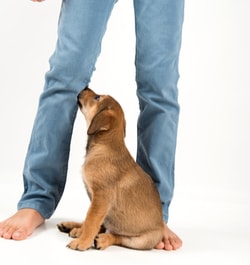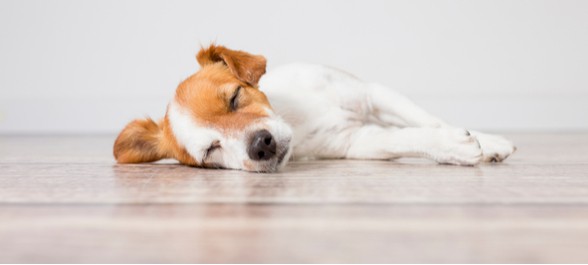The way a dog sits can tell you a lot about their mood, health condition, and general happiness. A dog’s body language and habit are readable, and the more you get to know your dog, the more you notice.
Both sitting and sleeping positions give you an insight to what your dog is thinking and feeling.
We can read dogs by their body language, just like we read people’s body language. The most obvious is an aggressive dog’s stance, or a cowering dog in fear.
The way people sit is an indication of their mood, or feelings, and dogs are no different. The way a dog sits can actually tell us a great deal of things.It’s the same with their sleeping position as well, so we’ll look at that too, because they go hand in hand.
We also learn a lot from where a dog sits, not just how they are sitting. Whether they are sitting on the floor with legs stretched out, or they are sitting on us, they are telling us something.
The way your dog sits could be a sign of bonding, or it could be a sign they aren’t well.
- The puppy sit: Puppies make most people laugh when they run around and their limbs seem uncontrollable. When they sit, their limbs just seem to splay outwards. This is completely normal for puppies because they have very flexible joints.
However, if an older dog suddenly starts sitting with its limbs splayed out, and they haven’t done that in the past, there could be an underlying health issue making them do that.
Consider an appointment at the vets.
There are a number of things that a sudden or gradual change could be:
- Joint pain and stiffness
- Arthritis
- Spine pain
- Inflammation of muscles
Your dog may be just sitting in a position that takes the pain away from their joints, back, or muscles. The key is looking forchangedbehavior as they may be switching positions to accommodate their discomfort that is not easily noticeable to you otherwise.
Two very common, yet serious conditions will make a dog sit in certain ways, and it’s important to get your dog checked if you think these conditions are present.
- Hip Dysplasia:Pain is caused by inflammation;your dog has to shift its weight and sitting position to get comfortable. Dogs with hip dysplasia may sit normally, but often shift around and walk gingerly to avoid pain, so watch how your dog gets into the sitting position, and gets up and moves.
Sometimes, with hip dysplasia, a dog will extend one leg or the other out to the side.
- Torn Cruciate Ligament: Often your dog won’t want to extend or stretch out the leg with a torn ligament. It is usually the unaffected leg that extends out to the side.
Where Dog’s Sit Says A Lot as Well

- Sitting at your feet: This is usually your dog showing you that you are the leader and they will sit where you do. Enjoy the bonding time.
- Sitting on your head: This could be your dog trying to show dominance, or get their scent on you, but in my dogs case (which I think is common) it’s just her trying to sit as close to me as possible, and she hasn’t quite figured out where to sit.
- The straight sit: This is taught in obedience schools to sit in front of you and is the healthiest sitting position for a dog. They should have a nice straight spine, with both knees off to the side in a symmetrical pattern.
Reasons Why Dogs Sit on You
It’s not only how and where dogs sit, but where they sit when interacting with you. Sitting on their owners is a common thing for dogs and for the most part, it’s a perfectly natural habit.
- Attention: All dogs love attention, and what better way to get it than by plonking themselves on you?
- Breed Specific: Small dogs love to sit on their owner’s lap. It’s a safe place to be for them. Big dogs also like to sit on their owners as well, and it goes to show that no matter how uncomfortable it is for them due to their size, they love being close to you.
- Security: You are the alpha and they know that you’ll protect them and keep them safe. It’s a real compliment to you from them.
- Dominance: This is the only time your dog sitting on your lap is a negative thing. If they think they dominate you, or are seeking too, they may sit on you so that you are under them. You will need to stop them from doing it, and only allow them to when you say so.
Some Dogs Sit Like Humans: What Does it Mean?
Often dogs with long limbs will sit on their backside on a sofa, with their legs extending out the front like a human. There must a huge amount of YouTube videos and memes showing this funny quirk.
Often it may be your dog imitating you, or it’s because they have realized that thisposition takes pressure off their lower spine and they get relief.
If your dog sits like this often, and you notice stiffness when they get up or walk, schedule a check-up at the vets.
If there are no other issues such as difficulty walking or getting up, and your dog is happy, it’s likely that they just like sitting like that.
Why Your Dog Sits in Your Spot When You Get Up
Ever noticed how the moment you get up, especially in the car, your dog jumps into your spot? There are a number of reasons why they do this.
They may just want to sit where your scent is, or to take advantage of the warm spot you’ve left behind.
There may be an element of status, and your dog is trying to exert their dominance, but this is rare. A dog trying to be dominant won’tjump back to their original spot when you return like most dogs do.
If your dog jumps into your spot and looks petrified that you’re going, they may be suffering from separation anxiety. If this is the case, you should seek professional help to remedy the problem because it often gets worse over time.
Dogs Sleep in Our Beds to Be Safe in thePack
If your dog wants to sleep in your bed, it’s up to you whether you allow it. Most people think their dogs are just after warmth and company, but it goes deeper than that.
Dog’s wolf ancestors lived in groups and they were vulnerable when sleeping and at night. For safety and warmth, they slept together in their packs. Your dog is in your pack, and you are the alpha.
Just make sure that as the alpha, you decide whether you allow your dog on your bed at night. You should also decide where on the bed your dog gets to sleep.
Sleeping Positions Say as Much as Sitting Positions

Our dog’s lineage goes back a long way, and many of their habits are ingrained and common to all of them. This includes the positions they get into when sleeping.
Let’s look at a few of the positions you will see your dog sleeping in, because like sitting, sleeping positions tell us a lot.
- Side Sleeping: When your dog lies on their side with legs outstretched, they are comfortable in their surroundings. This position makes them vulnerable, so if they had any concerns about where they were, they wouldn’t be in this relaxed pose.
- Curled in a Ball: Some dogs just prefer this position, but it is often used when the temperature is a little low for their liking. A dog curled up like this may be trying to make themselves as small as possible for safety reasons as well. Many dogs in shelters sleep in this position.
- Superman: This is usually reserved for smaller dogs, as large dog’s joints often don’t accommodate this position very well. They lie on their stomach and stretch their legs in front and behind like superman flying through the air. This is a position that allows a relaxed dog to stretch out without a care in the world.
- Lion Pose: Lying with their front paws outstretched and their head resting on their legs means your dog is just resting. They aren’t in a deep sleep.
We all know dogs are such quirky animals and have their own distinct personalities. This is the same as their habits and preferences. Sometimes dogs just sit in a way that they prefer, make them feel safe, or to take discomfort away.
You know your dog, so if you see sudden or gradual changes to their sitting or sleeping positions, consider whether you need to get them checked for any health issues.
Writer: Craig Taylor

Sources
https://pawleaks.com/dog-sitting-positions-what-they-mean/
https://www.dvm360.com/view/bad-hips-and-knees-it-hip-dysplasia-or-torn-cruciate-ligament
https://wagwalking.com/behavior/why-do-some-dogs-sit-like-humans
https://wagwalking.com/behavior/why-do-dogs-sit-in-your-spot-when-you-get-up
https://www.puppytip.com/why-does-my-dog-sit-on-me/
https://www.petmd.com/dog/wellness/5-dog-sleeping-positions-and-what-they-mean

